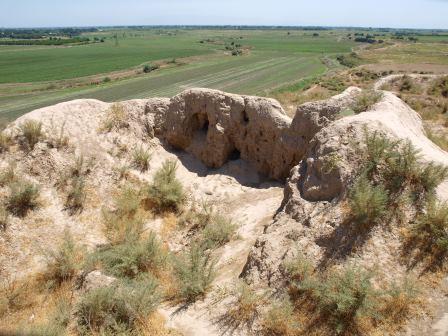21st August 2013 Tashkent, Uzbekistan
A Lost City
On Sunday I set off out of Tashkent to find the ancient city of Kanka, which the UNESCO website describes as “unique as a monument of history and human culture and the town-planning history of Uzbekistan, and included in the list of ten great sites of ancient cities of Central Asia”.
It isn’t really a lost city, but unfortunately most of the references to Kanka on the internet and in guidebooks describe it as being to the southeast of Tashkent, when in fact it’s to the southwest, and the fascinating entry on the UNESCO website gives an entirely incorrect map reference. I spent much of Friday evening and Saturday morning trawling the internet, trying to find some clearer directions, and even calling a travel company in Tashkent – who have photographs of it on their website, but aren’t sure where it is – but concluded only that it must be somewhere in Akkurgan district. So on Sunday I set off for Akkurgan, intending to ask there and see if I could find the site. It wasn’t obvious when I reached Akkurgan whom I should ask, but luckily I spotted an open door at the office of the Farmers’ Union. I thought that if anybody ought to know their way around the surrounding countryside it was a farmers’ organisation, so I went in and spoke to a Union official, who sent me off with full and clear directions. As I was setting off, he ran out of the office and said that a friend of his, a former party official who had been visiting him in his office, would be happy to show me the way.
We drove out of Akkurgan and through farming country for another 10 or 15 kilometres. For the last part of the journey we could clearly see the mounds of the old city and its surrounding fortresses standing up above the flat farmland. The city itself is reminiscent of the desert fortresses between Khiva and Nukus, although here we were in well-watered farmland so everything was much greener, and the city was more overgrown with vegetation. Like some of the desert fortresses – and indeed like many mediaeval cities in Europe – it consists of a citadel on a little hill top, and big areas beyond enclosed by what were once high walls. In parts of the citadel it’s possible to see the construction from ancient mud bricks. In most of the rest of the site one can make out raised areas and depressions that indicate structures of some sort, but it would need a specialist to distinguish what they are. The site was apparently inhabited from the fourth century BC to the 11th century AD. The local farmers are still turning up ancient coins and pottery in their fields.
We talked about our families, and reminisced about travelling in the Soviet period. My guide was the same age as me, but already has five grandchildren, having married rather younger than I did. We both had fond memories of some of the Black Sea resorts in the 1980s, in what seems now almost like another world.

Quite interesting. And it is sad that some of the travel agencies dont have proper infos about such places